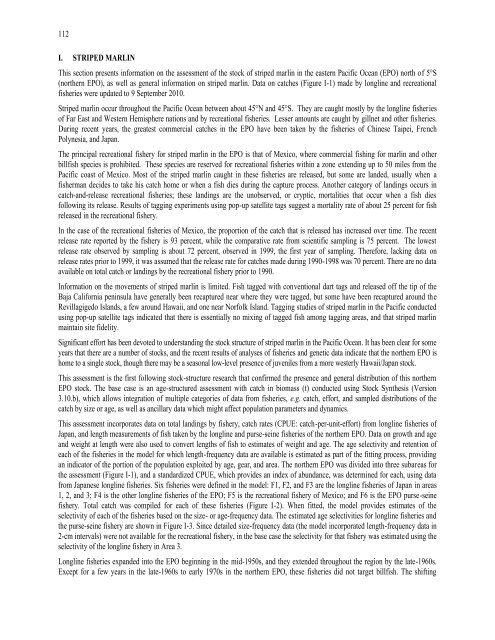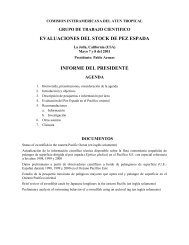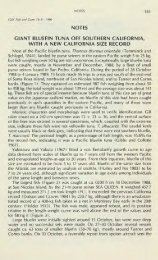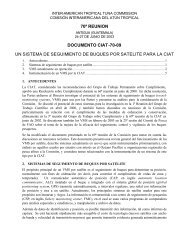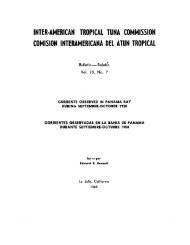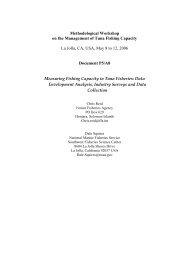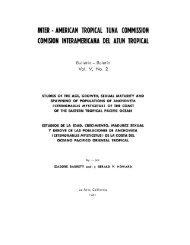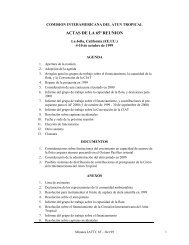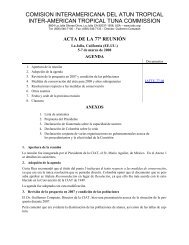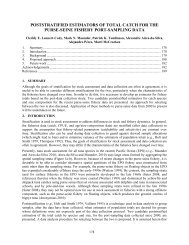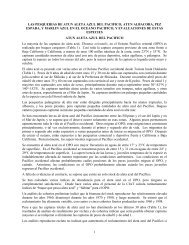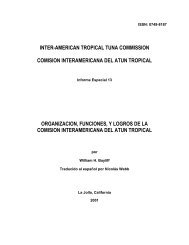IATTC Fishery Status Report 8 - Comisión Interamericana del Atún ...
IATTC Fishery Status Report 8 - Comisión Interamericana del Atún ...
IATTC Fishery Status Report 8 - Comisión Interamericana del Atún ...
Create successful ePaper yourself
Turn your PDF publications into a flip-book with our unique Google optimized e-Paper software.
112<br />
I. STRIPED MARLIN<br />
This section presents information on the assessment of the stock of striped marlin in the eastern Pacific Ocean (EPO) north of 5°S<br />
(northern EPO), as well as general information on striped marlin. Data on catches (Figure I-1) made by longline and recreational<br />
fisheries were updated to 9 September 2010.<br />
Striped marlin occur throughout the Pacific Ocean between about 45°N and 45°S. They are caught mostly by the longline fisheries<br />
of Far East and Western Hemisphere nations and by recreational fisheries. Lesser amounts are caught by gillnet and other fisheries.<br />
During recent years, the greatest commercial catches in the EPO have been taken by the fisheries of Chinese Taipei, French<br />
Polynesia, and Japan.<br />
The principal recreational fishery for striped marlin in the EPO is that of Mexico, where commercial fishing for marlin and other<br />
billfish species is prohibited. These species are reserved for recreational fisheries within a zone extending up to 50 miles from the<br />
Pacific coast of Mexico. Most of the striped marlin caught in these fisheries are released, but some are landed, usually when a<br />
fisherman decides to take his catch home or when a fish dies during the capture process. Another category of landings occurs in<br />
catch-and-release recreational fisheries; these landings are the unobserved, or cryptic, mortalities that occur when a fish dies<br />
following its release. Results of tagging experiments using pop-up satellite tags suggest a mortality rate of about 25 percent for fish<br />
released in the recreational fishery.<br />
In the case of the recreational fisheries of Mexico, the proportion of the catch that is released has increased over time. The recent<br />
release rate reported by the fishery is 93 percent, while the comparative rate from scientific sampling is 75 percent. The lowest<br />
release rate observed by sampling is about 72 percent, observed in 1999, the first year of sampling. Therefore, lacking data on<br />
release rates prior to 1999, it was assumed that the release rate for catches made during 1990-1998 was 70 percent. There are no data<br />
available on total catch or landings by the recreational fishery prior to 1990.<br />
Information on the movements of striped marlin is limited. Fish tagged with conventional dart tags and released off the tip of the<br />
Baja California peninsula have generally been recaptured near where they were tagged, but some have been recaptured around the<br />
Revillagigedo Islands, a few around Hawaii, and one near Norfolk Island. Tagging studies of striped marlin in the Pacific conducted<br />
using pop-up satellite tags indicated that there is essentially no mixing of tagged fish among tagging areas, and that striped marlin<br />
maintain site fi<strong>del</strong>ity.<br />
Significant effort has been devoted to understanding the stock structure of striped marlin in the Pacific Ocean. It has been clear for some<br />
years that there are a number of stocks, and the recent results of analyses of fisheries and genetic data indicate that the northern EPO is<br />
home to a single stock, though there may be a seasonal low-level presence of juveniles from a more westerly Hawaii/Japan stock.<br />
This assessment is the first following stock-structure research that confirmed the presence and general distribution of this northern<br />
EPO stock. The base case is an age-structured assessment with catch in biomass (t) conducted using Stock Synthesis (Version<br />
3.10.b), which allows integration of multiple categories of data from fisheries, e.g. catch, effort, and sampled distributions of the<br />
catch by size or age, as well as ancillary data which might affect population parameters and dynamics.<br />
This assessment incorporates data on total landings by fishery, catch rates (CPUE: catch-per-unit-effort) from longline fisheries of<br />
Japan, and length measurements of fish taken by the longline and purse-seine fisheries of the northern EPO. Data on growth and age<br />
and weight at length were also used to convert lengths of fish to estimates of weight and age. The age selectivity and retention of<br />
each of the fisheries in the mo<strong>del</strong> for which length-frequency data are available is estimated as part of the fitting process, providing<br />
an indicator of the portion of the population exploited by age, gear, and area. The northern EPO was divided into three subareas for<br />
the assessment (Figure I-1), and a standardized CPUE, which provides an index of abundance, was determined for each, using data<br />
from Japanese longline fisheries. Six fisheries were defined in the mo<strong>del</strong>: F1, F2, and F3 are the longline fisheries of Japan in areas<br />
1, 2, and 3; F4 is the other longline fisheries of the EPO; F5 is the recreational fishery of Mexico; and F6 is the EPO purse-seine<br />
fishery. Total catch was compiled for each of these fisheries (Figure I-2). When fitted, the mo<strong>del</strong> provides estimates of the<br />
selectivity of each of the fisheries based on the size- or age-frequency data. The estimated age selectivities for longline fisheries and<br />
the purse-seine fishery are shown in Figure I-3. Since detailed size-frequency data (the mo<strong>del</strong> incorporated length-frequency data in<br />
2-cm intervals) were not available for the recreational fishery, in the base case the selectivity for that fishery was estimated using the<br />
selectivity of the longline fishery in Area 3.<br />
Longline fisheries expanded into the EPO beginning in the mid-1950s, and they extended throughout the region by the late-1960s.<br />
Except for a few years in the late-1960s to early 1970s in the northern EPO, these fisheries did not target billfish. The shifting


